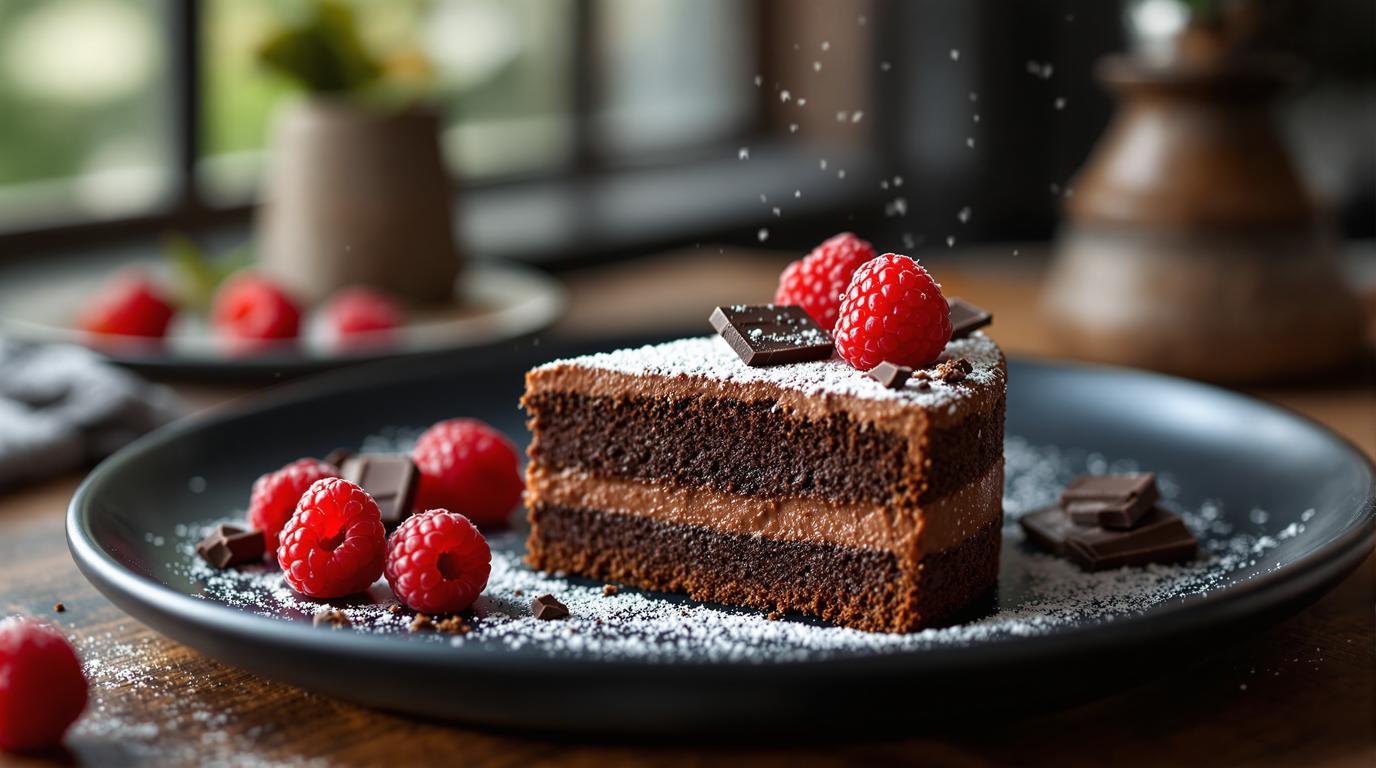The first time I tasted a proper gâteau au chocolat was during my apprenticeship in a small patisserie outside Lyon. The head chef, a stern woman with hands shaped by decades of kneading and whisking, insisted we learn this cake before anything else. “This is the foundation,” she would say, her accent thick with French precision. “Master this, and you understand everything about balance.” What makes this cake extraordinary isn’t complexity—it’s quite the opposite. The magic lies in how just five simple ingredients transform into something transcendent when treated with respect. 🍫
The Story Behind French Chocolate Cake 📖
French chocolate cake dates back to the early 19th century when refined chocolate became more accessible to home bakers. Unlike its American counterparts that often lean heavily on sweetness, the French tradition celebrates chocolate’s natural complexity—slightly bitter, deeply aromatic, with that characteristic melt-in-your-mouth quality that signals proper technique.
What truly distinguishes this cake is the separation of eggs—a technique that creates that signature texture: dense yet somehow light, moist without being soggy. This method has been passed through generations of French grandmothers, who understood that proper folding of whites creates micro-pockets of air that give the cake its distinctive character. 🇫🇷
Essential Ingredients 🧾
For a classic 8-inch cake that serves 8:
- 7.5 oz (210g) dark chocolate (70% cocoa content)
- 3.5 oz (100g) unsalted butter
- 5 large eggs, separated and at room temperature
- 7.5 oz (210g) granulated sugar
- 3.5 oz (100g) all-purpose flour
- Pinch of salt
- Confectioners’ sugar for dusting
The quality of chocolate here isn’t negotiable—it’s the star. I recommend a proper 70% dark chocolate like Valrhona or Guittard, though a good-quality grocery store brand will work if it has a clean, pure taste. Your chocolate should list cocoa mass or liquor as its first ingredient, not sugar. 🔍
Step-by-Step Instructions 📝
- Preheat your oven to 325°F (170°C) and prepare an 8-inch springform pan by lining the bottom with parchment and lightly buttering the sides.
- Create a double boiler by placing a heatproof bowl over a pot of gently simmering water (ensuring the bowl doesn’t touch the water). Add chocolate and butter, allowing them to melt slowly together. Stir occasionally until completely smooth, then remove from heat.
- While the chocolate mixture cools slightly, separate your eggs, placing whites in a clean, grease-free bowl (any fat will prevent proper whipping).
- Whisk egg yolks with half the sugar until pale and doubled in volume. The mixture should fall in ribbons when lifted.
- Fold the cooled chocolate mixture into the yolk mixture, then sift and gently fold in the flour and salt.
- In a separate bowl, whip egg whites until foamy, then gradually add the remaining sugar, beating until soft peaks form—they should curve gently when you lift the beater.
- Carefully fold one-third of the whites into the chocolate mixture to lighten it, then fold in the remainder with a gentle hand, maintaining as much air as possible.
- Pour the batter into your prepared pan and bake for 30-35 minutes. The cake is done when a toothpick inserted comes out with a few moist crumbs—never wait until it’s completely clean or your cake will be dry!
- Allow to cool in the pan for 10 minutes before releasing the sides. The cake will deflate slightly as it cools—this is expected and creates that characteristic fudgy interior.
Chef’s Note: Never rush the egg white folding process. I like to think of it as a gentle dance—too aggressive and you lose the air that creates the cake’s texture; too tentative and you’ll have unpleasant streaks of white. Use a large metal spoon and cut through the center, then scoop around the edges in a figure-eight motion. This technique took me months to perfect as an apprentice.
Chef’s Secret Techniques 🤫
The temperature of your ingredients matters enormously. Room temperature eggs incorporate air more effectively than cold ones. I learned from my French mentor to place eggs in warm water for 5 minutes if forgotten on the counter.
For a gluten-free version that maintains integrity, substitute an equal weight of almond flour for all-purpose flour. This creates a slightly denser but absolutely delicious cake with a subtle nutty undertone that complements the chocolate beautifully. In fact, my grandmother from Provence always made it this way, calling it a “gâteau fondant au chocolat.” 💭
If you don’t have a proper double boiler, place your chocolate and butter in a microwave-safe bowl and heat in 20-second intervals at 50% power, stirring between each interval. This prevents scorching, which would leave bitter notes in your cake.
Serving & Presentation Tips 🍽️
In France, this cake is often served unadorned except for a light dusting of confectioners’ sugar—a testament to the purity of its flavor. I recommend serving it slightly warm or at room temperature, never cold from the refrigerator.
A small dollop of homemade crème fraîche or unsweetened whipped cream makes a perfect accompaniment. If you’re feeling indulgent, fresh berries macerated with a touch of apple vinegar provide a lovely acidic counterpoint.
This cake pairs beautifully with a glass of Banyuls, a fortified sweet wine from southern France, or even a simple espresso prepared the traditional way. The bitter notes in both complement the chocolate perfectly. ☕
This gâteau au chocolat reminds us that true culinary excellence often comes from simplicity—not from complicated techniques or rare ingredients, but from understanding how to coax the best from what we have. Just as my grandmother would say while teaching me to make proper breakfast dishes, the beauty of cooking lies in the respect we show our ingredients. Master this cake, and you’ll understand why the French consider baking not just a skill, but a form of love expressed through butter, sugar, and in this case, the timeless allure of chocolate. 🤎
